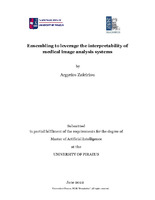Ensembling to leverage the interpretability of medical image analysis systems

Master Thesis
Συγγραφέας
Ζαφειρίου, Αργύριος
Zafeiriou, Argyrios
Ημερομηνία
2022-06Επιβλέπων
Μαγκλογιάννης, ΗλίαςMaglogiannis, Ilias
Προβολή/
Λέξεις κλειδιά
Medical AI ; Computer vision ; Explainability ; Interpretability ; Attribution mapsΠερίληψη
Modern Artificial Intelligence (AI) systems have been achieving human-level and, in
some cases, even higher predictive capabilities, solving numerous and various tasks. Two
primary reasons behind this accomplishment are the rapid technological evolution, and
the rising volume of available data, both of which allowed the development of
multimillion parameter models. Inevitably, along with accuracy, complexity has also
risen. But no matter how high the accuracy may be, some tasks, including any medicalrelated task, require explanations about the model’s decision. When dealing with image
data, the explanations of the model’s decision usually take the form of salient and nonsalient areas over the image that highlight the important and non-important areas
respectively. Whichever the importance attribution method though, the saliency of an
area represents the view of the model towards the stimuli that influenced mostly the
outcome and can be as accurate as the quality of the features the model has learned.
Thus, a plausible assumption would be that the better predictions the model makes, the
more accurate explanations it produces. In this work, the efficacy of ensembling models
as a means of leveraging explanations is examined, under the concept that ensemble
models are combinatory informed. Apart from ensembling, a novel approach is herein
presented for the aggregation of the importance attribution maps, in an attempt to
examine an alternative way of combining the different views that several competent
models offer. The purpose of aggregating is to lower computation costs, while allowing
for the combinations of maps of various origin. Following a saliency map evaluation
scheme, four tests are performed over three datasets, two of which are medical image
datasets, and one is generic. The results indicate that explainability can, indeed, benefit
from the combination of information, either by ensembling or aggregating. Discussion
follows, in an attempt to provide insight over the mechanics that led to the provided
results, as well as to give guidelines for potential future work.


